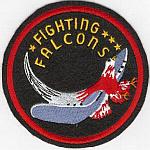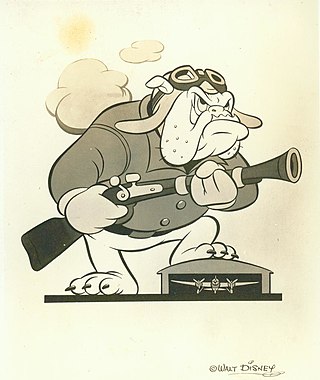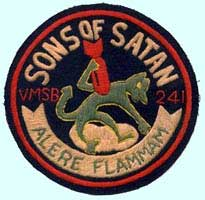
Marine Fighting Squadron 221 (VMF-221) was a reserve fighter squadron of the United States Marine Corps. Originally commissioned during the World War II, it flew the Brewster F2A-3, and after reconstitution in 1943, the F4U Corsair. The squadron, also known as the “Fighting Falcons”, is most notable for its actions on June 4, 1942, during the Battle of Midway, which resulted in 23 members of the squadron, many posthumously, being awarded the Navy Cross for their actions in combat. VMF-221 ended World War II with 185 air-to-air victories, the second most of any Marine Fighting Squadron in the war.

Marine Aviation Training Support Group 22 (MATSG-22) is a United States Marine Corps aviation training group that was originally established during World War II as Marine Aircraft Group 22 (MAG-22). Squadrons from MAG-22, were decimated at the Battle of Midway and after reconstituting fought during the Battle of Okinawa. The group was deactivated following the end of the war and were not reactivated until May 1, 2000, when the Marine Aviation Detachment at Naval Air Station Corpus Christi, Texas was renamed MATSG-22.

Marine Defense Battalions were United States Marine Corps battalions charged with coastal and air defense of advanced naval bases during World War II. They maintained large anti-ship guns, anti-aircraft guns, searchlights, and small arms to repel landing forces.

3rd Littoral Anti-Air Battalion is a United States Marine Corps aviation command and control and air defense unit that is optimized for operations in the first island chain. The battalion is based at Marine Corps Base Hawaii and falls under the command of the 3rd Marine Littoral Regiment and the 3rd Marine Division.

Walter Lewis John Bayler was a brigadier general in the United States Marine Corps who was famed during World War II as the "Last Man Off Wake Island" and the only American to see combat at Wake Island, Midway and Guadalcanal. A naval aviator and communications engineer, he was at the forefront of the Marine Corps' use of radar for early warning and fighter direction. He was one of the driving forces behind the Marine Corps' establishment of an air warning program and served as the first commanding officer of the 1st Marine Air Warning Group.
The 2nd 90mm Antiaircraft Artillery Gun Battalion was a United States Marine Corps antiaircraft unit that was active during the 1940s & 1950s. Originally formed during World War II as the 9th Defense Battalion, the battalion took part in combat operations on Guadalcanal, Rendova, Munda Point, and Guam. Like most other Marine defense battalions, the unit was re-designated in September 1944, becoming the 9th Antiaircraft Artillery Battalion. Returning to the United States in 1946, the battalion was again re-designated, this time as the 1st Antiaircraft Artillery Battalion. The battalion received its final designation as the 2nd 90mm Antiaircraft Artillery Battalion on August 21, 1950. It was later decommissioned on September 15, 1956 at Marine Corps Base 29 Palms, California.
The 2d Antiaircraft Artillery Battalion was a United States Marine Corps antiaircraft unit that served during World War II. Formed in 1940 as the 2d Defense Battalion, its original mission was to provide air and coastal defense for advanced naval bases. During the war the battalion defended Hawaii, Tutuila in American Samoa and Guam and took part in combat operations at Tarawa Atoll and Okinawa. The battalion returned to the United States after the war and was decommissioned at Marine Corps Base Camp Pendleton, California on 28 November 1945.

The 8th Antiaircraft Artillery Battalion was a United States Marine Corps antiaircraft unit that served during World War II. Formed in 1942 as the 8th Defense Battalion, its original mission was the air and coastal defense of advanced naval bases. During the war the battalion defended Tutuila in American Samoa, Wallis Island and Apamama and took part in combat operations at Okinawa. The battalion returned to the United States after the war and was decommissioned on 28 November 1945.

The 12th Antiaircraft Artillery Battalion was a United States Marine Corps antiaircraft unit that served during World War II. Formed in 1942 as the 12th Defense Battalion, its original mission was providing air and coastal defense for advanced naval bases. During the war the battalion defended the Russell Islands and took part in combat operations at Woodlark Island, Cape Gloucester, and Peleliu. The battalion remained on Peleliu for the duration of the war and was finally decommissioned on Guam on 22 September 1945.
The 4th Antiaircraft Artillery Battalion was a United States Marine Corps antiaircraft unit that served during World War II. Formed in 1940 as the 4th Defense Battalion, its original mission was providing air and coastal defense of advanced naval bases. It was one of first five defense battalions deployed in support of the color-coded war plans that called for the defense of Hawaii and other outlying United States possessions in the Pacific Ocean. These five battalions were nicknamed the "Rainbow Five." During the war the battalion took part in combat operations during the attack on Pearl Harbor and at Vella Lavella. The battalion was decommissioned on 9 June 1945 before the end of the war.
The 5th Antiaircraft Artillery Battalion was a United States Marine Corps antiaircraft unit that served during World War II. Formed in 1940 as the 5th Defense Battalion, its original mission was providing air and coastal defense for advanced naval bases. Prior to World War II the battalion deployed to Iceland as part of the 1st Provisional Marine Brigade in order to defend the neutral country from possible German attack. Following the Iceland deployment and a period of rest and refitting at home the battalion again deployed overseas to provide air defense for Funafuti in the Ellice Islands from September 1942 through February 1944. Also in 1942, two batteries from the 5th were dispatched to support operations on Tulagi during the Guadalcanal Campaign. These two batteries were later reorganized as part of the newly formed 14th Defense Battalion. The 5th Defense Battalion was re-designated as the 5th Antiaircraft Artillery Battalion in April 1944 and took part in the Battle of Okinawa in 1945. After the war the battalion returned to the United States where it was decommissioned in November 1945. Because the 14th Defense Battalion was formed from batteries belonging to the 5th Defense Battalion the two units retained close ties throughout the war. The 14th was nicknamed "Five:Fourteenth" and after the war the battalions formed a single alumni association.
The 7th Antiaircraft Artillery Battalion was a United States Marine Corps antiaircraft unit that served during World War II. Formed in 1940 as the 7th Defense Battalion, its original mission was to provide air and coastal defense for advanced naval bases. It was one of first five defense battalions deployed in support of the color-coded war plans that called for the defense of Hawaii and other outlying United States possessions in the Pacific Ocean. These five battalions were nicknamed the "Rainbow Five." During the war the battalion defended Tutuila, Upolu, Savai'i and Nanumea and took part in combat operations at Anguar. The 7th was decommissioned before the end of World War II on 2 August 1945.
The 10th Antiaircraft Artillery Battalion was a United States Marine Corps antiaircraft unit that served during World War II. Formed in 1942 as the 10th Defense Battalion, its original mission was to provide air and coastal defense for advanced naval bases. During the war the battalion took part in combat operations in the Russell Islands and at the Eniwetok. The battalion's tank platoon also saw extensive action on New Georgia and Arundel Island. The battalion was decommissioned before the end of the war on 25 November 1944.
The 11th Antiaircraft Artillery Battalion was a United States Marine Corps antiaircraft unit that served during World War II. Formed in 1942 as the 11th Defense Battalion, its original mission was to provide air and coastal defense for advanced naval bases. During the war the battalion defended took part in combat operations in the Solomon Islands. The battalion's tank platoon also saw extensive action on New Georgia and Arundel Island. The battalion was decommissioned before the end of the war on December 15, 1944.

The 17th Antiaircraft Artillery Battalion was an antiaircraft unit in the United States Marine Corps that served during World War II. The battalion was originally formed in 1942 as the 2d Airdrome Battalion and has the distinction of being the last defense battalion formed in the Marine Corps during the war. Its original mission was to provide air and coastal defense for advanced naval bases. During the war the battalion spent significant time defending Nukufetau and took part in combat operations at Tarawa and Tinian. The battalion was decommissioned on December 6, 1945.
The 15th Antiaircraft Artillery Battalion was an antiaircraft unit in the United States Marine Corps that served during World War II. The battalion was originally formed in 1942 as the 1st Airdrome Battalion. Its original mission was to provide air defense for advanced naval bases. During the war the battalion took part in combat operations in the Marshall. The battalion was one of the first defense battalions to be decommissioned on November 25, 1944.
The 14th Antiaircraft Artillery Battalion was an antiaircraft unit in the United States Marine Corps that served during World War II. The battalion was originally formed in 1943 as the 14th Defense Battalion. Its mission was to provide air and coastal defense for advanced naval bases. During the war the battalion took part in combat operations in the Solomon Islands and on Guam. The battalion was decommissioned on June 30, 1945. Since then no other unit has carried the lineage and honors of the 14th Antiaircraft Artillery Battalion.

The 3d Antiaircraft Artillery Battalion (Composite) (3d AAA Bn (Composite)) was an antiaircraft unit in the United States Marine Corps that served during World War II. The battalion was originally formed in 1943 as the 52d Defense Battalion, one of the first African American units in the Marine Corps. Its original mission was to provide air and coastal defense for advanced naval bases. During the war the battalion served as garrison forces on Roi-Namur, Majuro, and Guam. The battalion returned to Marine Corps Base Camp Lejeune, North Carolina after the war. It was the last of the defense battalions before it was re-designated as the 3d Antiaircraft Artillery Battalion in May 1946. The battalion was decommissioned on May 15, 1947.

Marine Attack Squadron 241 (VMA-241) was an aircraft squadron of the United States Marine Corps, known as the "Sons of Satan". The squadron was commissioned during World War II and took part in the Battle of Midway, sustaining 75% losses. It was extensively involved in combat while providing close air support during the 1944–1945 Philippines Campaign. The squadron, equipped with A-4 Skyhawk light attack aircraft, became part of the Marine Forces Reserve, based at Naval Air Station Los Alamitos, California, from 1946 until the 1960s.










